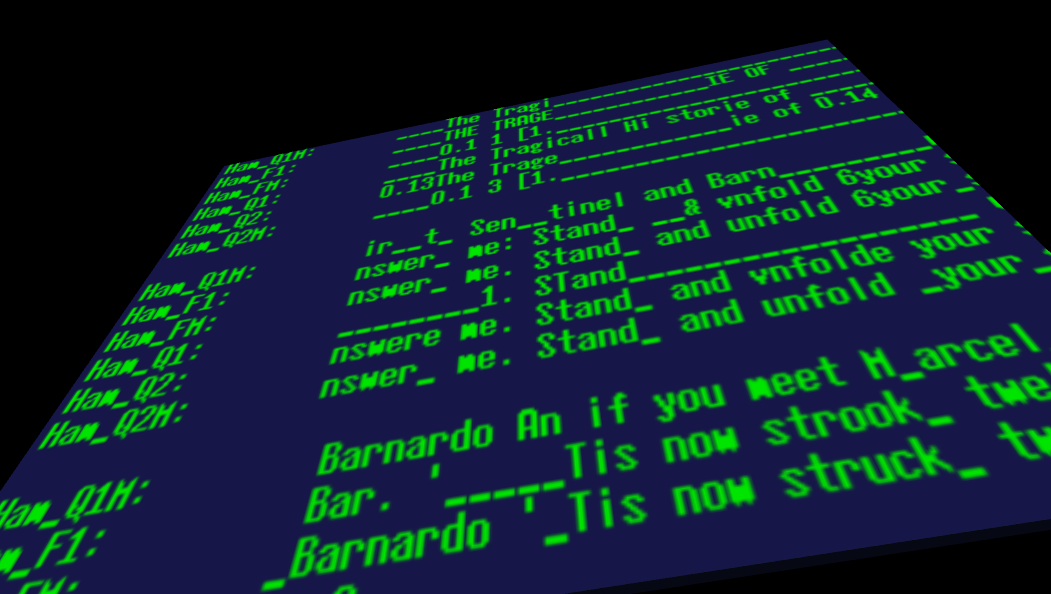SEE.DMU.AC.UK
The Centre for Textual Studies (CTS)
De Montfort University, Leicester, UK

What is this ?
The CTS Director, Prof Gabriel Egan, is Principal Investigator on a £312,012 AHRC-funded research project running from October 2016 to March 2018 that has the following objectives:
- To determine what the new computational techniques developed to distinguish authorship can tell us about the textual corruption and revision separating the various early editions--quartos (Q) and the 1623 Folio (F)--of the works of William Shakespeare, upon which all subsequent editions depend.
- Where co-authorship, revision and textual corruption all contribute to Q/F differences for a single Shakespeare play, to discover how far the new methods can distinguish them.
- To determine how best we can now explain Q/F differences for Shakespeare plays and so help today's editors to present them to modern readers, in the light of plausible theories of textual provenance, including hypotheses about how and why manuscripts of plays were recopied and how publishers received them.
This is the homepage for that project, where there will appear news about the project (see Whats New?) and where all materials generated by the project will be published for anyone to use under a Creative Commons Attribution (CC BY) licence.
So, what will the project do exactly?
We know what William Shakespeare wrote only because in his lifetime, and shortly after it, his works appeared in printed form from various small London publishers. With one small exception, we have none of his manuscripts, so all modern editions of Shakespeare are based on these surviving printed editions. About half of his works appeared during his lifetime in cheap single-play editions known as quartos and in 1623 (seven years after Shakespeare's death) a large collected works edition of 36 of his plays, known as the First Folio, was published with assistance from his fellow actors. Where we have both quarto and Folio versions of a play, they are never identical. Hundreds or thousands of 'variants' ranging from single words to whole lines, speeches, and even scenes are present or absent in one or other edition, or are entirely reworded and/or placed in a different part of the play. Unlike the plays, Shakespeare's poems were well published and present far fewer editorial problems.
Despite centuries of study, we cannot satisfactorily explain the quarto/Folio (Q/F) variants. Some will be errors made in the printing of one or other early edition, or in the prior copying of the lost manuscripts from which those printings were made. Others will be the results of censorship that required the toning down of religious expressions used as swear-words. Others still will be the results of Shakespeare changing his mind and revising a play after first composing it, or his fellow actors changing it with or without his consent. Just which reason explains each variant is hard to say because their results can be similar. As readers and editors of Shakespeare we want to find out which reason explains each variant because we want to correct the printer's errors and censorship but not to undo second thoughts and other kinds of revision in order to show modern readers what Shakespeare actually wrote. Where he or his fellows revised a play, we want to see how it stood before and after the revision in order to understand the motivations for changing it.
The newest discoveries about Shakespeare's habits of writing concern co-authorship. Scholars used to believe that except for short periods at the start and end of his career, Shakespeare habitually wrote on his own, but we now know that as many as one-third of his works were co-written with other dramatists. This has been shown by multiple independent studies using computational stylistics, which measure features of a writer's style that are invisible to the naked eye but can be counted by machines. For the past three decades, prevailing theories of authorship have suggested that where two writers collaborate on a work they blend their styles--effectively imitating one another--so that it would be all but impossible to decide later who wrote each part of the resulting composite work. Computer-aided analysis has proved this to be untrue: personal traits of writing can be discerned even where writers attempt to efface them.
This project will use the latest techniques in computational stylistics to study the problem of the Q/F variants. The techniques are particularly suited to (indeed, were first developed for) the discrimination of random corruption from systematic alteration. This discrimination goes to the heart of the Q/F variants problem: we want to know which differences result from mere errors in transmission and which are something else. Now that we have reliable tools to discriminate authorial styles, and have a reasonable set of baseline style-profiles for most of Shakespeare's fellow dramatists, we ought to be able to see how far artistic revision by Shakespeare and/or his collaborators caused the differences between the early editions, which remain our only access to Shakespeare. The better we understand the Q/F differences, the better account we can give of what Shakespeare actually wrote.
SEE Project Case for Funding Support
- The funding proposal for this project that was accepted by the UK Arts and Humanities Research Council is available here: accepted.pdf'